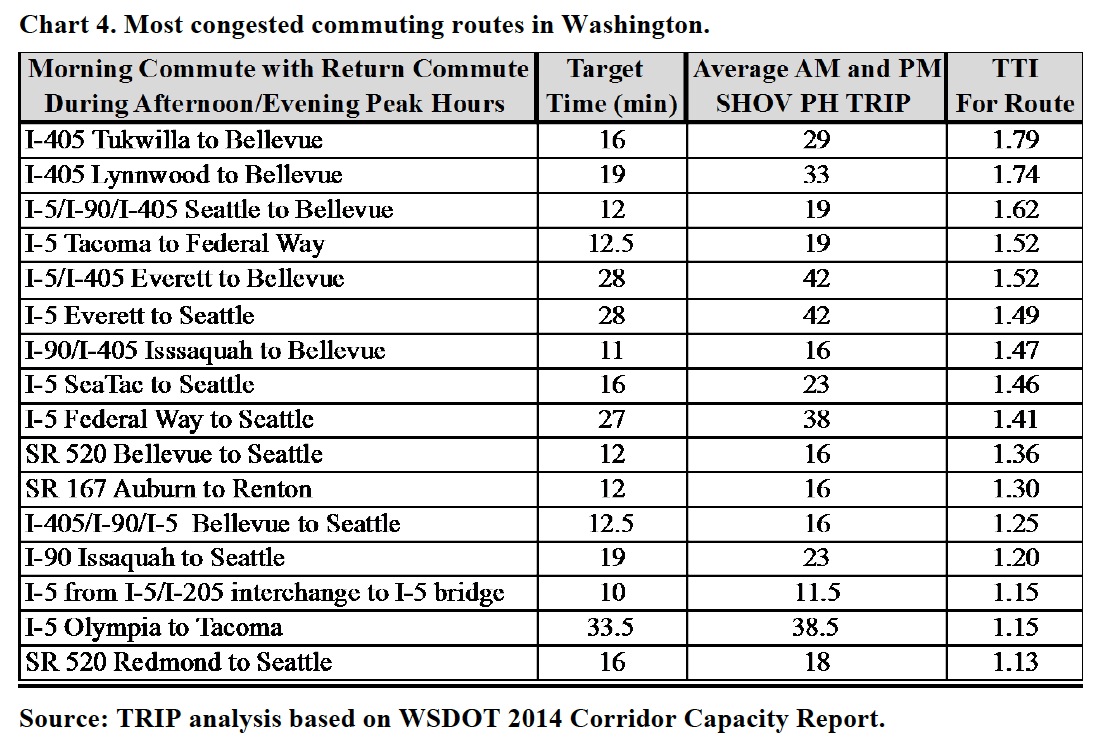TRIP
Introduction
Washington’s transportation system provides vital links for the state’s residents, visitors and businesses, providing daily access to homes, jobs, shopping, natural resources and recreation. Today, with the Evergreen State striving to support a high quality of life and economic competitiveness, the modernization of Washington’s transportation system is crucial, particularly to critical areas of the state’s economy including manufacturing, tourism, agriculture, and technology.
As the U.S. and Washington work to sustain long-term economic growth, the preservation and modernization of the state’s transportation system could play an important role in retaining Washington’s economic competitiveness and improving its economic well-being by providing needed jobs in the short term and by improving the productivity and competitiveness of the state’s businesses in the long term.
However, Washington faces numerous challenges in providing a transportation system that is safe, well-maintained, efficient and adequately funded. As Washington faces the challenge of preserving and modernizing its transportation system, the future level of federal, state and local transportation funding will be a critical factor in whether the state’s residents and visitors continue to enjoy access to a safe and efficient transportation network. Meeting Washington’s need to modernize and maintain its system of roads, highways and bridges will require significant local, state and federal funding.
In July 2014, Congress approved an eight-month extension of the federal surface transportation program, MAP-21 (Moving Ahead for Progress in the 21st Century Act), on which states rely for road, highway, bridge and transit funding, through May 31, 2015.
This report examines the condition, use and safety of Washington’s roads, highways and bridges, federal, state and local funding needs, and the future mobility needs of the state.
Population, Travel and Economic Trends in Washington
Washington’s residents and businesses require a high level of personal and commercial mobility. Population increases and economic growth in the state have resulted in an increase in the demand for mobility as well as an increase in vehicle miles of travel (VMT). To foster quality of life and spur economic growth in Washington, it will be critical that the state provide a safe and modern transportation system that can accommodate future growth in population, tourism, recreation and vehicle travel.
Washington’s population grew to approximately 7.1 million residents in 2013, a 45 percent increase since 1990. Washington had 5,301,630 licensed drivers in 2013. From 1990 to 2013, Washington’s gross domestic product (GDP), a measure of the state’s economic output, increased by 98 percent, when adjusted for inflation, surpassing the national average of 65 percent.
From 1990 to 2013, annual VMT in Washington increased by 28 percent, from approximately 44.7 billion miles to 57.2 billion miles.
Download full version (PDF): Washington’s Top Transportation Challenges
About TRIP
www.tripnet.org
Founded in 1971, TRIP ® of Washington, DC, is a nonprofit organization that researches, evaluates and distributes economic and technical data on surface transportation issues. TRIP is sponsored by insurance companies, equipment manufacturers, distributors and suppliers; businesses involved in highway and transit engineering and construction; labor unions; and organizations concerned with efficient and safe surface transportation.
Tags: Seattle, TRIP, WA, Washington







 RSS Feed
RSS Feed